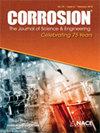Laser Surface Melting to Mitigate Intergranular Corrosion of Sensitized AA 5083
IF 1.3
4区 材料科学
Q4 MATERIALS SCIENCE, MULTIDISCIPLINARY
引用次数: 0
Abstract
AA5083 is a solution-strengthened, supersaturated Al-Mg alloy. It has become widely used in corrosive and harsh environments, such as marine settings, due to its exceptional corrosion resistance and impressive strength-to-weight ratio. However, when exposed to moderately elevated temperatures, the alloy undergoes a process called sensitization, resulting in the precipitation of the β-phase. This intermetallic precipitate is rich in magnesium and has anodic properties, creating a micro-galvanic couple with the more noble aluminum (Al) matrix. Consequently, the sensitized alloy experiences intergranular corrosion due to the anodic dissolution of the grain boundary in a corrosive environment. Various techniques for dissolving intermetallic particles (IMPs) into the matrix have been reported in the literature, but they are often impractical for service components, and traditional solutionizing treatments tend to decrease mechanical properties. This study aimed to investigate the impact of pulsed excimer laser irradiation, as a novel approach, on the surface morphology, chemical composition, and electrochemical behavior of highly sensitized AA5083 samples. To achieve this, various analytical techniques were employed, including profilometry, optical microscopy, scanning electron microscopy (SEM), energy dispersive spectroscopy (EDS), and localized potentiostat scans. The results of this investigation showed that laser surface melting (LSM) led to a reduction in the open circuit potential (OCP) and cathodic current density in a 0.6 M NaCl aqueous solution, mainly due to increased surface homogenization. Furthermore, multiple grazing incident X-ray diffraction (GIXRD) scans were performed to identify the changes in the metallurgical and crystallographic parameters in the near-surface region. Anodic polarization scans of the LSM surface galvanically coupled with a more cathodic base metal exhibited a lower corrosion current density than the theoretical value suggested by mixed potential theory. The improved performance could potentially be attributed to the surface homogenization and formation of a robust passive layer on the LSM surface.激光表面熔融技术缓解敏化 AA 5083 的晶间腐蚀
AA5083 是一种固溶强化的过饱和铝镁合金。由于其优异的耐腐蚀性和惊人的强度重量比,它已被广泛应用于腐蚀性和恶劣的环境中,如海洋环境。然而,当暴露在适度升高的温度下时,合金会经历一个称为敏化的过程,从而析出β相。这种金属间析出物富含镁,具有阳极特性,可与惰性较高的铝(Al)基体形成微电偶。因此,由于晶界在腐蚀环境中发生阳极溶解,敏化合金会出现晶间腐蚀。文献中报道了各种将金属间微粒(IMPs)溶解到基体中的技术,但这些技术对于使用中的部件来说往往不切实际,而且传统的固溶处理往往会降低机械性能。本研究旨在研究脉冲准分子激光辐照这种新方法对高度敏化 AA5083 样品的表面形态、化学成分和电化学行为的影响。为此,我们采用了多种分析技术,包括轮廓仪、光学显微镜、扫描电子显微镜 (SEM)、能量色散光谱仪 (EDS) 和局部恒电位仪扫描。研究结果表明,激光表面熔化(LSM)降低了 0.6 M NaCl 水溶液中的开路电位(OCP)和阴极电流密度,这主要是由于表面均匀化程度提高所致。此外,还进行了多次掠入射 X 射线衍射 (GIXRD) 扫描,以确定近表面区域冶金和晶体学参数的变化。对与阴极性更强的基体金属电耦合的 LSM 表面进行阳极极化扫描后发现,其腐蚀电流密度低于混合电位理论的理论值。性能的提高可能是由于表面均匀化以及在 LSM 表面形成了坚固的被动层。
本文章由计算机程序翻译,如有差异,请以英文原文为准。
求助全文
约1分钟内获得全文
求助全文
来源期刊

Corrosion
MATERIALS SCIENCE, MULTIDISCIPLINARY-METALLURGY & METALLURGICAL ENGINEERING
CiteScore
2.80
自引率
12.50%
发文量
97
审稿时长
3 months
期刊介绍:
CORROSION is the premier research journal featuring peer-reviewed technical articles from the world’s top researchers and provides a permanent record of progress in the science and technology of corrosion prevention and control. The scope of the journal includes the latest developments in areas of corrosion metallurgy, mechanisms, predictors, cracking (sulfide stress, stress corrosion, hydrogen-induced), passivation, and CO2 corrosion.
70+ years and over 7,100 peer-reviewed articles with advances in corrosion science and engineering have been published in CORROSION. The journal publishes seven article types – original articles, invited critical reviews, technical notes, corrosion communications fast-tracked for rapid publication, special research topic issues, research letters of yearly annual conference student poster sessions, and scientific investigations of field corrosion processes. CORROSION, the Journal of Science and Engineering, serves as an important communication platform for academics, researchers, technical libraries, and universities.
Articles considered for CORROSION should have significant permanent value and should accomplish at least one of the following objectives:
• Contribute awareness of corrosion phenomena,
• Advance understanding of fundamental process, and/or
• Further the knowledge of techniques and practices used to reduce corrosion.
 求助内容:
求助内容: 应助结果提醒方式:
应助结果提醒方式:


